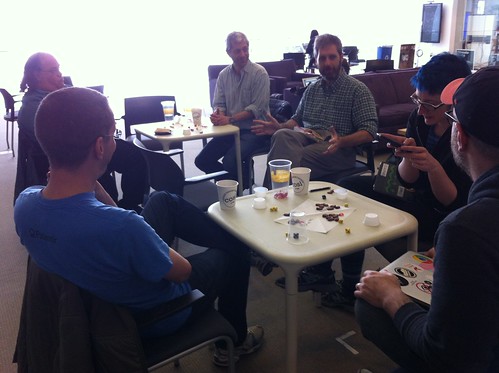Pablo is a force to be reckoned with. That crazy energy that seeps possibility into the most jaded of souls. He doesn’t just pull you out of yourself – he gives you somewhere to go. And even more incredibly is that he seeks to make the things he has made possible thrive beyond himself – how can he support others in making change? How can the things he’s instigated be documented and live on? A reminder of how much good facilitation matters in events and life.
We played a game of being Red Cross employees, responsibile for entire areas (my quandrants were dubbed after Lord of the Rings. The other was simply CMYK) and you “win” with the most resources put into long-term endeavors (HIV/AIDS education, infrastructure, education, etc) and with the fewest catastrophies (when you didn’t have the resources to respond to flooding in time). I could go on and on about the mechanics of the game, but really you should just play a round yourself. What matters are that we suddenly had a much better understanding of probability and consequence based on tangible interaction. I encourage you to read more at the multitudes of documentation on their specific branch fo the topic, often with recent MIT Conversation guest Colleen.

The main takeaway specfic to my tech-in-response-space and facilitator double-heart (+10 geek points if you get the reference) was the unapologetic conviction with which Pablo addressed uncertainty and unfairness in the game setup. Don’t understand? Oh well! 5.. 4.. 3.. Just like life. As someone who is constantly struggling to find balance between building capacity in dealing with chaos, and the ease of interaction that clear guidelines bring, this was beautifully blunt. Because the point of the game isn’t just optimizing for resource management, it’s in dealing with the unclear rules, political agendas, donor whims, and the other players that you have to worry about. The math can be gamed, graphed. The social interaction is far more fascinating and flexible.
This clearly wasn’t just about me – we were joined by an incredible group of people. For examples, Jason and Matt. Jason, from the Game Lab and a cohort of mine at the Media Lab, brought his long experience in improv, facilitation, and gaming to the.. table (I couldn’t help it! Pun!). From him, we had an examination of game structure regardless of content, of technical levels, and of on- versus offline-games. We were also joined by Matt from MetaLab and the MaleriaAction game – using human pattern-recognition abilities to cut down massively on computational modeling time. From him, we examined the continuum between what great work for people to play, to understand their systems, and what is great for modeling, and how that better understanding might feed back into tabletop games.

We also explored the brain-overloading awesome that somehow lets me into its structure on a regular basis : the MIT Media Lab. Specfically, we visited CityScope in Changing Places, LuminAR in Fluid Interfaces, and Paula Dawson‘s holograms in Object-Based Media. With City Scope, we examined how using city and environmental models in play – moving LEGOs around to try out different plans and structures – can lead to a similar base understanding as the tactile interaction the games brought. With LuminAR, how can we display the probability functions we had gotten a solid sense for via the games (rather than numbers or an undeciferable graph, a set of dice – one covered and one exposed) to people who actually need to know there are ways of optimizing their response and funding structures? How about projecting calculations based on the beans and dice they’ve laid out? And from the holograms, how can we see one aspect of a problem from one side of a table, but a very different perspective from the other side?
And always, for me, the Center for Civic Media idea of how this brings voice and understanding and storytelling to more people. And this is where game structure becomes so intersting. By having a clear game infrastructure with modules, you can build whatever game you like co-creatively. What are the major things to pay attention to? What would the costs and risks and win conditions be? By working with a group to discover what is important to them, you also understand what the complications are. AND it shows that systems are malleable. My favorite.
Epic thanks to everyone who made the day possible. I’m excited to see where we can take the enthusiasm, intentions, and heart as we forge ahead into a future that might just suck less. In no small part because we don’t just have scientific and mathematical inputs – but we understand what they mean, and how to use them.
